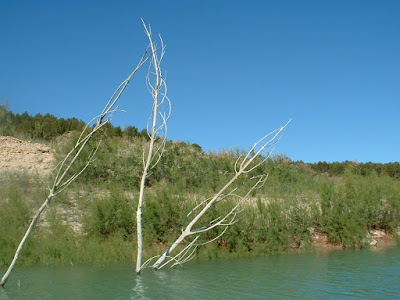This month was a record one for me – four outings in one month, all on Embalse de Negratin, launching at Playa de Freila each time. For some mysterious reason it was always on a Wednesday that the weather forecasts looked the most favourable for a bit of kayaking with my Gumotex Halibut:
Wed. April 3rd. - time on water 4 hrs. and 8.5 kilometres paddled. Start time 10:45h.
Wed. April 10th. - time on water 3¼ hrs. and 8.5 kilometres paddled. Start time 10:45h.
Wed. April 17th. - time on water 3¼ hrs. and 7.5 kilometres paddled. Start time 11:00h.
Wed. April 24th. - time on water 2½ hrs. and 5.4 kilometres paddled. Start time 10:00h.
The weather wasn't entirely in my favour on my last trip. What little wind there was at the start freshened after two hours, creating quite a chop on open water. Headed back to Playa de Freila a bit earlier than usual. Now know to avoid days where there's likely to be a westerly wind like that.
Visiting the reservoir regularly throughout April has been interesting. Week by week the water level rose, unlike the reservoirs in the drought stricken areas of the Costa del Sol. The river which feeds Negratin must have been collecting much rainwater run-off from the mountains further North. I paddled the same stretch of shoreline three times, and every time it looked different. Paddling in open water on Negratin is all well and good, but it's close to the shoreline where there's a chance of seeing something different. Even if it's only terrapin 'plopping' back into the water as you approach, or electric-blue damselflies darting around in the vegetation, as I saw this month.
A reminder to be aware that tops or branches can break off these dead trees at any time, especially on windy days. Whole trees could even fall unexpectedly.
Looks as if these trees are well on the way to collapsing. It's inevitable that all these dead trees will eventually collapse into the water – and the scenery around the edge of the reservoir will be the worse for it.
Early in the month I couldn't have got this far into this inlet. The water level had risen by at least a metre by the day of my last trip. Somewhere further into the inlet I could hear running water, but couldn't penetrate far enough to actually find the source.
Sun, wind and water has made natural sculptures from tree stumps and roots around the shoreline of the reservoir. On my April 3rd. trip there wasn't a suitable landing place, to go ashore and get near to this one – but, thanks to the rising water, I could land and take a photo of it three weeks later. This is one of the best I've seen.
This bit of sculpture was just drifting around. Bits and bobs of timber, previously high and dry, are now taking to the water.
A leg-stretch stop early in the month. That green, wispy/feathery looking vegetation in the water is growing in profusion along a lot of the shoreline. In some places it is growing 2 to 3 metres high. Took a piece home with me to try and identify it – initially without any success.
Invasive or what! That green vegetation doesn't seem to be bothered by the rising water level. Doesn't even mind being totally submerged. With the water quite clear, when the plants are only just covered it is like paddling above waving tree tops. Being very flexible with feathery foliage it is easily paddled through – other than where it's very dense.
Success! On my final trip that vegetation was in flower and much easier to identify, with the help of Google. It is a member of the Tamarisk family (also known as Saltcedar) and can even grow into fully fledged trees. Apparently in some parts of the world, especially in the U.S.A.. it's classed as an invasive species. Certainly proving very invasive here.
Another pull-out. I generally go ashore to stretch my legs at least once on every trip. Actually my bottom benefits from these stops more than my legs! Despite being an inflatable one, the seat pad of a Gumtex Halibut starts feeling a tad too hard after an hour or so. Seems to be a shared problem among us oldies – not long ago I came across quite a lengthy discussion, on a canoe & kayak forum, about how to make seats more comfortable for old butts!
When I was here in January this ramp didn't even reach the water. Now at least 30 metres of it is covered. That's 30 metres less of hauling back up to the car park!
The reflections on the water were magnificent that day.
Despite the considerable rise in water level, it's still a long way back up to there!
A month of quiet kayaking at it's best - with a bit of education, about Tamarisk, as a bonus. As you can see, Tamarisk appears somewhere in most of the photographs.











